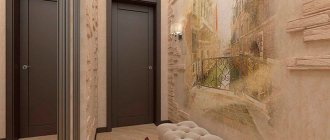Which chandeliers are suitable for the hallway and corridor
As practice shows, people try to choose the most modest, unremarkable lamps for the hallway and corridor. The main function of the selected device is to illuminate the space in which it is located for comfortable use of the room. It is for this reason that preference is given to small and functional models.
Today, lamps built into suspended ceilings, which are capable of creating an original composition on the surface, are especially popular. LEDs attract the least attention, which can result in the impression that the structure is emitting light on its own.
If necessary, you can choose hanging models for the corridor or hallway, which can give the room a luxurious appearance and become a central element located on the surface of the ceiling. The only thing worth considering in this case is the height of the ceiling. It should be about 2.5-3 m. If the height is less, then it is worth taking into account the fact that moving around the room in which the hanging model is installed will be quite problematic.
Before purchasing a lamp for a corridor or hallway, it is recommended to first take into account the size of the room that will be illuminated. It is these indicators that have a special impact on the number of shades used and their further placement. In addition, do not forget about the general power level. For example, if the room is small, then the total power can be about 80-100 W; for large rooms it is necessary to take from 120 W.
Attention! If necessary, you can see what the ceiling chandeliers for the corridor look like in the photo.
Corridor lighting: highlights
Windows in the hallway are the exception rather than the rule, so the space is illuminated around the clock exclusively with lamps.
They should emit light of such intensity and spectrum that there are no dark corners in the room. At the same time, there should not be a sharp difference between the lighting level of adjacent rooms and the corridor. This can cause negative emotions. Ceiling lamps in the corridor
should not flood the space with harsh light, nor should they be barely warm, so before purchasing them , look at what power they are designed for
. You need to find designs in which the lamps used will produce soft light, and the lampshade will successfully diffuse it.
combination of an antique chandelier with table lamps in the hallway
The easiest way to achieve this effect is to use frosted lamps, chandelier models with tinted lampshades, or products whose shades direct light flows to the ceiling, and not radically down.
In large corridors, where there is a need to install several ceiling lamps at once, you can look for unexpected solutions in their placement or use them in combination. An interior in which the ceiling lights in the hallway are hidden behind a suspended translucent ceiling structure will look original. If the room is low and it is not possible to install a suspended ceiling in it, you can simply run a regular cornice along the perimeter of the corridor and mount lighting behind it. This will be a wonderful addition to your existing ceiling lamps.
Now let's look at how lighting is organized in corridors of different layouts. In narrow and long rooms, lamps are placed in such a way that the light coming from them is reflected from the ceiling and walls. This technique helps to adjust the space on a visual level. The corridor immediately seems wider and more voluminous.
The main chandelier is complemented by several small ball-shaped pendant lamps
For high ceilings, it is better to use spotlights rather than chandeliers, because they allow you to adjust the direction of the flow of light rays, which is very important for rooms that resemble tunnels. Lighting in a well-shaped corridor should be organized so that the ceiling remains in the shadow and does not draw attention to itself. This can only be done by directing the light onto the walls.
Localization of corridor lighting
“In order to save money, you can install motion sensors, then
the lighting in the corridor will turn on only in the presence of a person”
The decor of any corridor certainly includes a mirror. It is quite possible that there will also be a dressing room in the room. Naturally, such places need additional lighting, therefore, when planning the placement of lamps in the corridor, they need to be given special attention. A good place to place the lamp would be the top border of the mirror frame. It is better to illuminate a large mirror with a pair of symmetrically placed lamps. If you plan to use the mirror exclusively for decorative purposes, then an LED strip will be more suitable for illuminating it.
the black chandelier is combined with dark photo frames that decorate the walls of the corridor
What is also important in this matter is the organization of lighting control. These could be standard switches or something more modern, like dimmers and other electronic “gimmicks”. To save money, you can install motion sensors, then the lighting in the corridor will turn on only in the presence of a person. This approach will allow you to save a lot on electricity.
Design ideas for organizing lighting
If you have any knowledge of electrical installations and are familiar with the basics of design, you can try to design your hallway lighting yourself. When placing sconces, floor lamps and other elements, do not forget that:
- The light, under no circumstances, should hurt the eyes with its brightness, however, twilight should not appear when it is turned on. An insufficiently lit corridor will appear visually smaller.
original chandelier in the form of a long strip to which several lamps are attached
- By installing several lamps on the side walls in the corridor so that the light streams coming from them intersect, refract and are absorbed by opposite surfaces , you can make even the narrowest room visually wider
. If you already have several ceiling lamps in your hallway, and changing them is not part of your plans, then rotate their shades so that the light does not fall on the floor, but shines as much as possible onto the walls.
- A high ceiling can be “lowered” without resorting to global reconstruction using expensive materials. Here again, properly selected lamps with adjustable radiation direction will come to the rescue. It doesn't matter where you attach them, as long as they shine in the right direction, namely towards the bottom of the walls. Since the ceiling will be lost in the darkness, the room will become much more proportional and comfortable.
organization of hidden corridor lighting
- Lighting in the hallway will again help you achieve a mysterious and enigmatic interior. Streams of light from built-in or hidden lamps will “rip out” the necessary objects from the environment, thereby creating a certain mood. The same technique can hide decorative imperfections. The play of light can smooth out all existing unevenness and unattractive roughness.
- The latest design achievement was the use of LED lights in the hallway. With their help, it is easy to adjust the degree of illumination of the space and its color spectrum, selecting it in accordance with the time of day or adjusting it to suit your mood.
- Thoughtful lighting can “raise” a low ceiling. To do this, it is enough to cover its surface with a mirror or glossy one and illuminate it with lighting built into the floor or wall plinth.
designer chandelier in the interior of a corridor decorated in a modern style
Design errors
“When choosing a lighting method in a corridor, you need to give preference to schemes that can correct the visual perception of space, rather than focusing on the brightness of the spilling light.”
Sometimes a seemingly great lighting idea turns out to be a complete utopia. What is good for volumetric spaces will be perceived, to put it mildly, as inadequate in a limited corridor area. The urge to use chandeliers should be nipped in the bud. Arranging the same type of bright lighting in a room with such functionality will place not quite the right accents and will attract excessive and unnecessary attention to it, exposing existing decorative or breading flaws. You can correct the situation by using a combination of different types of lighting.
classic chandelier in the interior of the corridor
When choosing a lighting method in the corridor, you need to give preference to schemes that can correct the visual perception of space, rather than focusing on the brightness of the spilling light. If you plan to install suspended ceiling structures, then integrate small spotlights into them. This will be a good design move, as it will fill the corridor with comfort. If you need to highlight some accent areas, use spots.
Supporting Recommendations
The corridor should not be depressing and make you want to run through it, cowering, without looking back. To ensure that you experience only positive emotions when entering this room, try to follow the following recommendations.
– The number of lamps in the corridor should be such that the light they emit is as bright as in adjacent rooms. If the corridor borders the bedroom, the light in which is dim, then you need to organize soft lighting in it too.
a glass chandelier with a metal frame will fit perfectly into the modern style of the corridor
– General lighting must certainly be supplemented with local lighting. Typically, ceiling lamps are complemented by sconces and built-in lighting.
– In a long corridor, it makes sense to divide the space into light zones. In this case, it will be perceived comfortably and will no longer seem like a “pipe”. The color and power of light emission in each zone will be different. Hidden lighting in the ceiling, made by spotlights or directional lamps, will allow you to achieve a similar effect.
– If the corridor is spacious and contains a lot of doors and cabinets, it is worth creating an accent light zone. The object of intense lighting in the corridor can be, for example, a niche or shelf. In these places you need to organize mini-exhibitions, say, of interesting photographs, replicas of weapons, unusual masks, original dishes. All this wealth is illuminated by directed streams emanating, for example, from spots. The rest of the area is illuminated by lighting. These can be built-in lamps and LED strips.
chandelier in the interior of a Mediterranean hallway
– In high corridors it makes sense to hang a chandelier. It will “lower” the ceiling, making the ceiling closer. If the corridor is long, it would be more appropriate to illuminate it with several single-arm chandeliers.
– Low ceilings make the room closed, creating an oppressive atmosphere in it. Proper lighting of the corridor will dispel these illusions. Select a set of small wall sconces with lampshades facing the ceiling, and the light coming from them will solve problems of spatial perception.
Important installation points
When carrying out electrical installation work, lay the wires with a reserve. That is, make several additional lines, put reserve ends in a single switch. This will be useful if you want to increase the number of devices in the future and improve the quality of room lighting.
small glass chandelier in an oriental interior
Plan in advance how many sockets and switches you need, what type they should be and where exactly they should be located. Lights in a long corridor should be turned on at both ends of the room. This will make them more comfortable to use.
Switches can be standard: keypads or push-buttons, but in modern interiors it is better to replace them with motion sensors.
The number of shadows from the lamps in the corridor will be less if you arrange them chaotically or in a cascade, rather than in one straight line.
many glass pendant lamps emphasize the severity of hi-tech style
Do not neglect the lighting standards in the corridor. Sanitary rules were not invented by chance, but were developed specifically to ensure that your health is safe.
If a mini living space is formed in the corridor, then you can create a comfortable atmosphere in the work areas using automatic control, similar to an office one. Such systems are programmable and allow you to easily change the lighting intensity in the desired areas of the room, turn on and off selected lamps in the corridor and do much more. Thanks to this functionality, the system was given the definition of “Smart Light”.
many small pendant lamps in the hallway
Conclusion
A properly designed lighting scheme will be ineffective if fixtures and lamps of the wrong class are purchased for the corridor. In the design of this room there is absolutely no place for daylight fixtures equipped with fluorescent lamps. Their light distorts color rendering, and therefore the perception of space. Makeup applied or a drawing done in such lighting will look tasteless in normal light. Ideally, the corridor is illuminated with halogen lamps. An alternative to them, although not the most economical, is conventional incandescent lamps.
Types of ceiling chandeliers in the hallway
Despite the wide range of products, lighting fixtures can be divided into 2 types:
- ceiling;
- wall-mounted
As a rule, ceiling lighting fixtures are installed at some distance from the ceiling surface. Such models have a number of advantages:
- quite easy to carry out installation work;
- if necessary, you can independently adjust the installation height;
- easy to maintain products during operation.
Unfortunately, all of the above advantages lose their effect for rooms with low ceilings. If the ceiling height in the hallway or corridor does not exceed 2 m, it is recommended to give preference to surface ceiling chandeliers. In addition, it is worth considering that installation work in such a situation will be a little more complicated, since it will be necessary to additionally install a mounting strip. As a result, the lamp will not only not be pressed tightly against the surface of the ceiling, but also will not take up much space.
Wall lighting fixtures are made from a large number of materials that combine quite well with interior design. On sale you can find models made from the following materials:
- crystal - can make the room as bright as possible, thanks to the shimmer of light it has an attractive appearance;
- glass - such options may have various protrusions and recesses, such a solution can maintain the clarity of the lighting in the room;
- anti-glare plates - this type of material can provide velvety and cozy lighting in the corridor and hallway;
- textiles - chandeliers for the production of which fabric was used, this can make the interior design pleasant and delicate.
Many experts recommend choosing wall-mounted models for hallways and corridors - this option is perfect for rooms with low ceilings. Such lighting fixtures do not hang from the ceiling surface and do not interfere with movement. If you choose wisely, you can visually enlarge the room.
Advice! Chandeliers that include only 1 shade are perfect for corridors.
Types of chandeliers for the hallway
If you are faced with the issue of choosing a chandelier, then you need to know some rules. However, first we advise you to familiarize yourself with the types of such products.
There are a lot of varieties and listing them all would be quite a long task. But there is a criterion according to which the gradation occurs in only two options
This criterion is the location and, depending on it, wall and ceiling chandeliers are divided.
There may, of course, be floor lighting options for the hallway. But this type of lamps is rarely used.
Firstly, the floor lamp takes up space, which is already not enough in the hallway space.
And, secondly, such lighting is not very good and is used only as an additional type of light.
A mirror is most often installed in the hallway, and in order to see yourself well in it, excellent lighting is necessary.
Ceiling chandeliers in the hallway are more used in the corridor space and they are more familiar to everyone.
If the ceiling is very low and there is not enough space for a chandelier, then wall lighting comes to the rescue.
In addition, they significantly expand the space. For this function, of course, it is necessary to choose the right type of light bulb so that it gives the correct and necessary light.
Size of ceiling chandeliers in the corridor
In the selection process, you should adhere to the basic rule - the smaller the area of the room used, the more modest the appearance of the chandelier should be. But there is no need to assume that for large rooms you should choose simply huge options - everything should be as harmonious as possible. If necessary, you can choose not only ceiling lighting fixtures, but also wall ones, thereby advantageously highlighting areas that are of particular importance to the apartment owner.
When choosing a chandelier for a long corridor or small hallway, it is recommended to adhere to the following tips:
- if the room has a square shape, then you should give preference to round or square versions of chandeliers; the installation must be carried out in the center of the room;
- in the case where the room is rectangular, the lighting fixture should be slightly elongated, which will allow the light to be diffused over a large area;
- for narrow corridors, it is best to choose lampshades whose width is about 1/3 of the room;
- for a long hallway or corridor, you will need to install several lighting fixtures, and the lampshades should be round or square;
- For large rooms, rotating models on a rod or flexible holder are perfect.
If you follow these recommendations, you can choose the appropriate chandelier option for any room, regardless of its size and height. Standard fixtures can be advantageously combined with wall lamps - thanks to this combination, the room will acquire the desired effect, and minor flaws in the decor will be hidden.
Methods for visual correction of room sizes
In order to visually increase the height of the walls, it is necessary to direct the flow of light to the ceiling by turning the sconce horn upward. To make the corridor wider, you need to place spotlights in several rows perpendicular to a long wall or rotate the lighting fixtures so that they shine on the walls.
Installing a wardrobe with mirrored doors or a mirrored wall in a narrow and long hallway will not expand the space; it will only complicate cleaning the room. In addition, you can distract attention from the size of the room by directing the light from the sconce to a wall with an interesting finish: embossed wallpaper, decorative plaster or brickwork.
As you can see, proper lighting in a small hallway is a difficult task, but very important. We hope that this information will help you highlight all the advantages and hide all the disadvantages of this “border with the outside world.”
Choosing a color for a chandelier in the corridor: photo
The color scheme is not in last place. When making a purchase, many experts recommend carefully ensuring that the color of the chosen lamp is combined with other elements present in the interior design. This is due to the fact that a competent choice of color will allow you to advantageously emphasize certain places.
If preference was given to bright colors, then you should understand that in this case the chandelier will become the central element in the hallway or corridor. Translucent or transparent lamps can set off the leading color scheme. In order to choose the right lighting device, you should first think about how exactly this option will be combined with the design of the room.
Mounting options
Depending on the mounting location, lighting can be ceiling, wall, built-in furniture and even floor. If you have a small hallway with high ceilings, then it seems like a well. In this case, designers suggest:
- make suspended or suspended ceilings with spotlights around the perimeter. They will visually enlarge the room and make it more comfortable;
- install several single lamps on a long leg in a high-tech style. The ceiling will visually come closer and cease to be a well;
- use the spots, turn the lamps down and on the walls. The hallway will seem larger and brighter.
In a hallway with low ceilings, install flat ceiling lights or those with a very short stem. The hall may well be illuminated by a chandelier from the ceiling, spots, LED lamps, and spotlights. Here a lot will depend on the overall design of the room.
When we talk about wall lighting, we mean, first of all, sconces. But the adjacent corridor can be illuminated using LED lamps built into a plastic matte box. And LED strips will help make the backlight more prominent. Such illumination can be placed under the ceiling, above the floor or in the form of a pattern along the entire wall.
Lamps can also be built into the wall, as well as into the ceiling. If your walls are finished with plasterboard or plastic, then the built-in lamps will resemble nautical-themed portholes or scatter like sunny dandelions all over the wall
Built-in lighting in furniture will help to locally focus attention on some decorative element: a mirror, a cabinet, a painting, a panel, a photograph. In this case, in the closet you can place spotlights on open shelves or place a solid horizontal lamp on top of the closet
The light can also be turned on by photocells when closing and opening the cabinet.
The most unusual solution is the lighting located on the floor. To do this, LED frosted lamps are placed below the floor level so that they appear to be one with the flooring. Such light should be placed around the perimeter of the corridor and packaged in a box made of transparent durable plastic.
Design of chandeliers in the hallway: photo
As practice shows, almost any owner of a small room tries with all his might to make it larger, at least visually. In this matter, oddly enough, the correct choice of lighting plays a special role. To visually increase the space, it is recommended to give preference to finishing materials in light colors. Light surfaces are subsequently able to reflect light, as a result of which designers recommend making small corridors and hallways as light as possible. The luminous flux must be directed to the upper half of the walls and to those places where the intersection of walls and ceiling occurs.
Features of lighting rooms of different shapes
Lighting should also be selected based on the shape of the corridor. In modern apartments there are hallways of this type:
- long;
- small;
- square or L-shaped.
Each type of hallway has its own recommendations and winning solutions.
Long corridor
It is the long and narrow corridor in the apartment that will require special tricks (in the photo) in lighting; here a couple of wall sconces will not be enough.
A narrow corridor with spot lighting and a large backlit canvas, which looks very impressive and also serves as an additional light source
Lighting will help adjust the space and visually balance it. The best solution is spotlights, not only on the ceiling, but also along the wall at a height of 20-30 cm from the floor.
Convenient grouping:
2 lamps above the front door. Ceiling “points” along the entire length with the same distance from each other. Lighting fixtures built into the cabinet. This is more likely not a design refinement, but an improvement in functionality.
A narrow corridor in light colors with a row of lamps that evenly illuminate the entire room
If the corridor is narrow and the ceiling is high, then you should use another technique - place lighting along the walls, without installing ceiling lighting at all. This solution will make the corridor visually wider and the ceilings lower. If it is too narrow, it is worth installing lighting, for example, a wall sconce, on only one wall.
An unusual solution for a narrow apartment corridor - walls decorated with brickwork, which is emphasized by the original lighting design
If you are planning several types of lighting, it is worth powering them from different switches - this will allow you to turn on not all at once, but separately.
Small corridor
In such a room it is worth dividing the lighting into general and local. The central part of the composition will be a ceiling chandelier with a matte shade. If a suspended ceiling is installed in the corridor, then you can install spotlights
It is important not to overdo it with local lighting, then the room will look attractive
A small corridor in Scandinavian motifs, illuminated by one lamp in the center of the room
Square, L-shaped corridor
A square is considered the ideal shape, and this rule also works for a corridor. A square hallway is most convenient to illuminate. Here it is quite possible to hang an original chandelier in the center, and it will be the main source of light. If you make a two-level suspended ceiling in this room, you can organize the light using LED strip. Another original solution would be to place rotating lamps on the ceiling in the corners, without a central fixture. Such lighting can be used simultaneously - as main and as local.
Spacious corridor in light colors with a combined type of lighting
The L-shaped corridor should be divided into functional zones, grouping lighting of different types into them. The main thing is not far from the front door. Local zones - near the cabinet, mirror, decorative elements, etc.
L-shaped corridor in a spacious apartment in light colors
The contrasting combination of light walls and dark floors creates an atmosphere of lightness without overloading the space in the L-shaped corridor
Ceiling chandeliers in the hallway: photos in the interior
A ceiling chandelier is an integral part in the design of any interior. Thanks to the wide range of products, you can not only choose the appropriate option, but also quite easily get lost in such abundance. In this case, it is recommended to look at what different models of chandeliers look like in interior design.
Combination of chandelier and hallway style
If you choose a specific pendant chandelier model for the corridor, then you need to pay attention not only to the dimensions, but also to the style of this room. Geometric shapes of the product are more suitable for emphasizing a modern interior, while unusual or exclusive shapes are more suitable for classics.
You can complement any style with the help of fusion chandeliers, as they are considered universal and suitable for hallways in a classic style.
Some hallway design styles need additions. For example, with an ultra-modern design, you should not install a universal version of the lighting fixture. Sometimes you can achieve amazing results by mixing styles, but it's best to listen to a design expert's opinion.
To avoid making mistakes, it is recommended to pay attention to the following tips:
- The hallway is the first room of the home that greets visitors coming from the street, so you can experiment with street motifs by installing lantern-like chandeliers on the ceiling;
- If the decoration of the hallway contains wood or bamboo, then it is better to choose a chandelier with wooden or elements imitating this material;
- To emphasize the high-tech style, a pendant chandelier with a nickel-plated frame is installed.
When deciding on the optimal product model, it is important to pay attention to its color and design.
A suspended translucent or completely transparent chandelier model, which will only have a light tone, will help to set off the overall color scheme of suspended ceilings. To complement the Art Nouveau style in the hallway, it is better to use a bright model, which will be the center of the corridor. In this case, design solutions are appropriate.
How to properly light a mirror in a hallway
The easiest way would be to install a sconce near a mirror on the wall. However, time moves forward, and today a huge number of mirrors with built-in light bulbs have been developed. A mirror, especially if it is massive and large, must be well lit.
This will provide an opportunity not only to:
- Consider your image;
- To do makeup;
- Get your hair done.
The rays of light should not strain the eyes, the light should be pleasant for visual perception. The ideal solution is a simple-shaped device with a matte, non-dark shade that will soften the light, make it diffused and pleasing to the eye. It would be great to choose lamps that have a shade that moves in different directions, as well as lighting devices on flexible brackets.
You can read about how to choose a good mirror for the hallway in our next material:.
Homemade repairs and installation of lighting can be quite successful if you listen to the advice of professionals.











